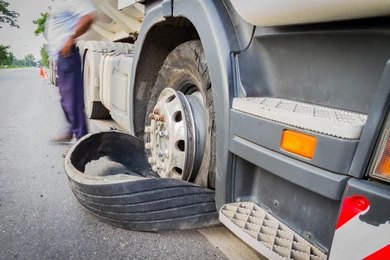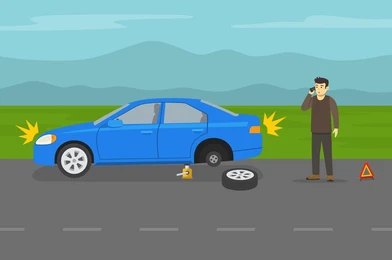A tyre blowout is one of the most alarming events a driver can experience on the road. The sudden loss of air pressure or the complete failure of a tyre can cause the vehicle to swerve uncontrollably, putting both the driver and other road users in significant danger. Understanding the causes of tyre blowouts, knowing how to prevent them, and being prepared for what to do in an emergency are essential for ensuring your safety on the road. In this blog, we’ll break down the causes of tyre blowouts, explore prevention tips, and guide you through the proper steps to take in case of an emergency.
What Is a Tyre Blowout?
A tyre blowout occurs when a tyre suddenly bursts, resulting in the complete loss of air pressure and potential destruction of the tyre itself. Blowouts can happen without warning, and while they are relatively rare, they can be catastrophic. Tyre blowouts are most common at high speeds, particularly on highways, but they can also happen in urban areas or on poorly maintained roads.
Causes of Tyre Blowouts
Various factors contribute to tyre failure, and often a combination of conditions will lead to a blowout. Below are the primary causes:
1. Under-Inflation
The heat causes the tyre material to break down, weakening its structure. This can result in a blowout, especially when driving at higher speeds. A lack of proper air pressure reduces the tyre’s ability to absorb shock and increases the likelihood of friction-related damage.
2. Overloading
Each tyre is designed to support a certain weight, and exceeding this weight limit can lead to excess pressure on the tyres. When tyres are overloaded, they are more likely to overheat, crack, or even blowout. Always check the vehicle’s manual for recommended load limits and avoid carrying excessive weight.
3. Worn-Out Tyres
Tyres that are worn out or have low tread depth are far more likely to experience a blowout. Worn-out tyres do not have the necessary grip to handle the road conditions, making them vulnerable to punctures, damage, and sudden failure. A tyre with minimal tread cannot effectively channel water away from the contact patch, increasing the risk of hydroplaning, especially in wet conditions. Regularly inspecting your tyres for wear and replacing them when necessary is crucial to reducing the risk of a blowout.
4. Sharp Objects and Debris
Sharp objects such as nails, glass, or debris on the road can puncture the tyre and weaken its structure. Even a small puncture, if left unaddressed, can lead to a sudden blowout. This is especially true for tyres that are already in a weakened state due to age, wear, or under-inflation. It’s always a good idea to check your tyres periodically for signs of punctures or embedded debris.
5. Extreme Temperatures
Tyres are sensitive to temperature changes. On the other hand, extremely cold temperatures can cause the air inside the tyre to contract, leading to under-inflation. Both conditions can contribute to tyre blowouts. Heat is particularly damaging, as it accelerates the breakdown of the rubber and can cause a blowout, especially when combined with other factors such as under-inflation or overloading.
6. Manufacturing Defects
While less common, manufacturing defects can cause tyres to fail prematurely. Defects such as weak spots in the rubber, faulty sidewalls, or poor quality control during production can lead to catastrophic tyre failure. It’s important to check for recalls and be aware of the manufacturing history of your tyres, especially if they are older or part of a known defect.
Prevention of Tyre Blowouts
While it’s impossible to completely eliminate the risk of a tyre blowout, there are several key steps you can take to significantly reduce the chances of one occurring. Here are some crucial prevention tips:
1. Check Tyre Pressure Regularly
Under-inflated tyres are more prone to overheating and blowouts, so make it a habit to check your tyre pressure monthly, and before long trips. Use a reliable tyre pressure gauge to ensure that the pressure is within the recommended range specified by the vehicle manufacturer.
-
-
- Rotate Tyres Frequently
-
Rotating your tyres regularly helps ensure even wear, which can prolong the lifespan of the tyres and reduce the risk of blowouts. Most manufacturers recommend rotating tyres every 6,000 to 8,000 miles (or as specified in the owner’s manual). Rotating the tyres helps distribute the wear and tear, especially in the front tyres, which often bear more weight due to braking and steering.
3. Inspect Tyres for Damage
Before heading out on a trip, always visually inspect your tyres for any signs of damage, such as cracks, bulges, or punctures. Check for embedded debris and remove any objects that may have lodged in the tread.
4. Avoid Overloading Your Vehicle
As mentioned earlier, overloading your vehicle can place undue pressure on your tyres. Always be mindful of the weight limits specified in the vehicle’s manual. If you regularly carry heavy loads, consider upgrading to tyres that are rated for higher load capacities.
5. Choose Quality Tyres
Investing in high-quality tyres from reputable brands can also reduce the risk of a blowout. Quality tyres are more durable, resistant to wear, and better able to withstand extreme temperatures and road conditions.
6. Drive Cautiously
Avoid aggressive driving, including sharp turns, rapid acceleration, and hard braking, as these actions put additional stress on your tyres. Drive cautiously, especially when roads are wet or under construction, as debris and sharp objects may be more prevalent.
What to Do in a Tyre Blowout Emergency
Despite all your best efforts, tyre blowouts can still occur. Knowing what to do in an emergency is vital for your safety. Here’s a step-by-step guide on how to handle a tyre blowout:
1. Stay Calm
The first step is to stay calm. Panic can cloud your judgment and make the situation worse. Take a deep breath and focus on maintaining control of the vehicle.
2. Grip the Steering Wheel Firmly
Keep the grip of your hands tight on the steering wheel to maintain control of the vehicle. Don’t jerk the wheel suddenly; instead, try to keep the car straight and avoid swerving.
3. Slow Down Gradually
Gradually release the accelerator your car will o slow down on its own. Do not hit the brakes suddenly, as this can cause the car to skid. Use slow braking and bring the car to a safer speed.
4. Pull Over to a Safe Location
Once the vehicle has slowed down, steer it towards the shoulder of the road or a safe area, such as a parking lot. Turn your hazard lights on to alert others on the road.
5. Change the Tyre or Call for Help
If you know how to change a tyre, do so quickly and safely. If you’re not comfortable with changing the tyre, or if you’re on a busy highway, call for roadside assistance. Never attempt to change a tyre in an unsafe area.
Conclusion
Tyre blowouts are an unsettling but preventable danger on the road. Understanding the causes, taking preventive measures, and knowing how to react in an emergency can help reduce the risk of a tyre blowout and keep you safe while driving. Regular tyre maintenance, careful driving, and awareness of your surroundings are essential to ensure your vehicle’s tyres remain in good condition and ready to withstand the challenges of the road. Stay vigilant, check your tyres regularly, and drive safely to prevent the unexpected from turning into a dangerous situation.






